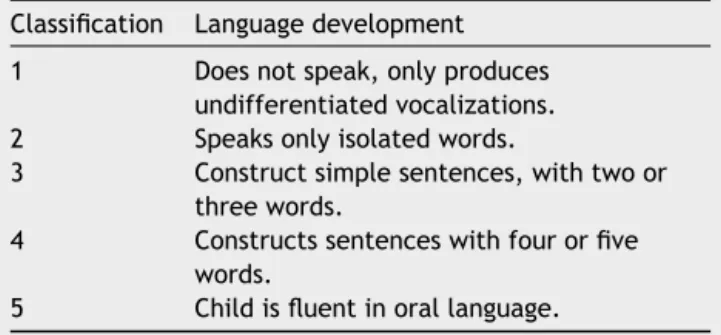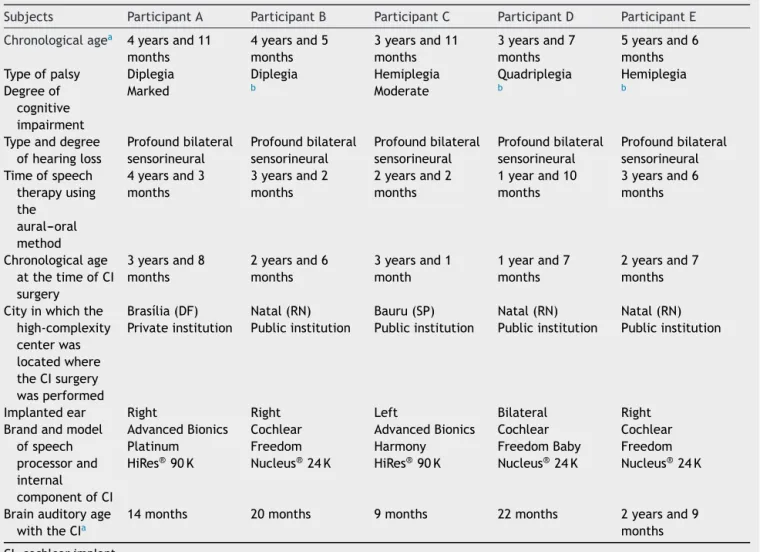www.bjorl.org
Brazilian
Journal
of
OTORHINOLARYNGOLOGY
ORIGINAL
ARTICLE
Hearing
rehabilitation
in
cerebral
palsy:
development
of
language
and
hearing
after
cochlear
implantation
夽
,
夽夽
Anacléia
Melo
da
Silva
Hilgenberg
a,
Carolina
Costa
Cardoso
a,
Fernanda
Ferreira
Caldas
a,
Renata
de
Sousa
Tschiedel
a,b,
Tatiana
Medeiros
Deperon
c,
Fayez
Bahmad
Jr.
a,∗aDepartmentofHealthSciences,UniversidadedeBrasília(UnB),Brasília,DF,Brazil
bDepartmentofPsychology,CentroUniversitárioPlanaltodoDistritoFederal(UNIPLAN),Brasília,DF,Brazil cDivisionofAudiology,UniversityCollegeofLondon(UCL),London,England,UnitedKingdom
Received10November2013;accepted9March2014 Availableonline19October2014
KEYWORDS Cerebralpalsy; Cochlearimplants; Hearingloss
Abstract
Introduction:Auditoryrehabilitationinchildrenwithbilateralsevere-to-profound sensorineu-ral hearinglosswith cochlearimplanthasbeen developedinrecent decades;however,the rehabilitationofchildrenwithcerebralpalsystillremainsachallengetootolaryngologyand speechtherapyprofessionals.
Objective:Toverifytheeffectivenessofcochlearimplantsinthedevelopmentofauditoryand languageskillsinchildrenwithcerebralpalsy.
Methods:Aprospectiveanalyticalstudy.Theevaluationofauditoryresponsestospeechtest was applied to thechildren inthisstudy atregularintervals following implantation. Stan-dardizedteststhatassessandquantifythedevelopmentofauditoryandlanguageskillswere administeredandspeechtherapyvideorecordsandspeechtherapyfileswereanalyzed.All chil-drenwentthroughindividuallytailoredintensiveaudiologicalrehabilitationprogramsfollowing cochlearimplantation.
Results:Twoparticipantshadgradualauditoryandlanguagedevelopmentwhencomparedto otherparticipantswhoreachedadvancedlevelsinhearingandorallanguageclassifications.
夽 Pleasecitethisarticleas:HilgenbergAM,CardosoCC,CaldasFF,TschiedelRS,DeperonTM,BahmadJr.F.Hearingrehabilitationin
cerebralpalsy:developmentoflanguageandhearingaftercochlearimplantation.BrazJOtorhinolaryngol.2015;81:240---7.
夽夽Institution:Post-GraduationPrograminHealthSciencesofUniversidadedeBrasília,Brasília,DF,Brazil.
∗Correspondingauthor.
E-mail:cleiana23@hotmail.com(F.BahmadJr.). http://dx.doi.org/10.1016/j.bjorl.2014.10.002
Conclusion: TheuseoftheCochlearimplantenabledparticipantstoreachadvancedstagesof hearingandlanguageskillsinthreeofthefiveparticipantswithcerebralpalsyinthisstudy. Thiselectronicdeviceisaviabletherapeutic optionforchildrenwithcerebralpalsytohelp themachievecomplexlevelsofauditoryandlanguageskills.
© 2014Associac¸ãoBrasileira de Otorrinolaringologiae CirurgiaCérvico-Facial. Publishedby ElsevierEditoraLtda.Allrightsreserved.
PALAVRAS-CHAVE Paralisiacerebral; Implantecoclear; Perdaauditiva
Reabilitac¸ãoauditivanaparalisiacerebral:desenvolvimentodaaudic¸ãoelinguagem apósimplantecoclear
Resumo
Introduc¸ão: Areabilitac¸ãoauditivaemcrianc¸ascomdeficiênciaauditivaneurossensorialsevera aprofundabilateralcomoImplanteCoclearfoiconsagradonasúltimasdécadas,contudo,ainda permaneceumdesafioparaaotorrinolaringologiaeafonoaudiologiaareabilitac¸ãodoportador deparalisiacerebral.
Objetivo: VerificaraefetividadedoImplanteCoclearnodesenvolvimentodashabilidades audi-tivasedelinguagememcrianc¸ascomparalisiacerebral.
Método: Estudo analítico prospectivo. Foram aplicados testes padronizados que avaliam e quantificam o desenvolvimentodas habilidadesauditivase delinguagem. Foramanalisadas asfilmagensdasterapiasfonoaudiológicaseosregistrosdescritosaotérminodecadasessão deterapia.
Resultados: Ascrianc¸asanalisadasapresentaramdesenvolvimentoauditivoedelinguagem sat-isfatório quandocomparado àsdemais crianc¸as que alcanc¸aram níveis mais complexos nas categoriasdeaudic¸ãoeevoluc¸ãosignificativanodesenvolvimentodalinguagemoral.
Conclusão:OusodoImplanteCoclearfavoreceuoalcancedeetapasavanc¸adasdashabilidades deaudic¸ãoelinguagememtrêsdascincocrianc¸ascomparalisiacerebraldesseestudo.Esse dispositivoeletrônicotemsidoumaopc¸ãoterapêuticaviávelparaquecrianc¸ascomparalisia cerebralalcancemetapascomplexasnoqueserefereàshabilidadesauditivasedelinguagem. ©2014Associac¸ãoBrasileiradeOtorrinolaringologiaeCirurgiaCérvico-Facial.Publicado por ElsevierEditoraLtda.Todososdireitosreservados.
Introduction
Cerebral palsy (CP) is a non-progressive motor disorder resultingfrombrainimpairmentintheearlystagesofchild development.Thebasicneurologicalsymptomsare charac-terizedbymotordisordersthatdevelopovertime,causing delay or disruption of sensory motor development, with insufficient postural mechanism, presence of reflexes at timeswhentheyshouldbeinhibited,alterationsinmuscle tone,andincapacitytoperformmovements.1
Possibledisordersofhighercorticalfunctionscan gener-ateimportantimpactonactivitiesofdailyliving.Moreover, languageacquisitionmaybedelayedandthechildwithCP may exhibit changes in articulation, speech, fluency, and prosody. Its clinical manifestations may change over the courseofdevelopmentduetobrainplasticity,particularlyin theimmaturebrain.Duetothisplasticity,uninjuredareasof thebraincanassumesomeofthefunctionsofthedamaged areas.
Inadditiontomotorimpairment,otherdisabilitiesmay bepresent,suchashearing,visualandcognitivedeficits,as wellaslanguage,behavioral,andlearningalterations.1
The literatureshowsseveralcommonetiologicalagents for both CP and sensorineural hearing impairment.
Among them are congenital infections, hyperbilirubine-mia,prematurity,lowbirthweight,perinatalhypoxia,and cytomegalovirus,amongothers.
Thecochlearimplant(CI)isahigh-technologyelectronic device developed toperform the functionof damaged or absentcochlearhaircells,andtoprovideelectrical stimu-lationoftheremaining auditorynervefibers. The CIdoes notcuredeafness,butprovidesasenseofhearingwiththe requiredqualityfortheperceptionofspeechsounds.2
Currently,theCIisconsideredaviabletherapeuticoption incasesofchildrenwithCPandsevere/profoundbilateral sensorineuralhearinglosswhohavenotshownbenefitswith theuseofhearingaids.3---7
Thereareotheraspectstoconsider,whenother condi-tionsarepresentinthechildinadditiontohearingloss.Each disabilitythatisaddedtothedeafness,willpresentdistinct clinicalfeaturesthatwillinfluenceboththediagnostic eval-uation and the rehabilitation of the hearing impairment. Among other factors, hearing results will depend on the child’spotentialforhisorheroveralldevelopment.6
The sooner the brain receives meaningful sounds, the bettertheconditionsforittoproducegoodresults,because ofitsfunctionalplasticityandtheresultantdecreasein sen-sorydeprivation.
The work with CIs in children has transformed and improvedthespeechtherapyprocessduetotheimproved abilitytoperceivespeechsoundsfromtheelectrical stimu-lation.Thepossibilityofsuchprosthesestoprovideaccess toauditory experiences,suchasthe patternsof linguistic auditorycode,effectivelyinfluencestheearlyyearsoflife, whichdeterminethechild’sconstitution.8
The auditory system is the natural pathway to learn speech,andauditoryskillsareessentialforthedevelopment oforallanguageandspeechproduction;thus,effectivework is necessary for them todevelop. This work shouldoccur withina meaningful linguistic context for the child, asa natural result of incidental learning in situations of daily living.9
Itisthroughhearingthatinfantsacquirelanguage.The auditorystimuluscancomefromseveralsources:thehuman voice,householdsounds,toysounds,andmusic.10
Standardized tests and classifications of development areimportantasdescriptorsofthedevelopmentofachild withhearingloss,suchasthe:(1)Infant-Toddler Meaning-fulAuditoryIntegrationScale(IT-MAIS);(2)MacArthur-Bates Communicative Development Inventory (CDI); (3) Classifi-cationofauditory skills;and(4)Classificationof language skills.
IT-MAISwasproposedbyZimmerman-Phillipsin1997and is a test adapted for children younger than 4 years that evaluates responses to speech and environmental sounds thataremediatedexclusivelybytheauditorysensory path-way.This scale has alsobeen used toassess post-surgical outcomes of children with CI. The test consists of ten closed questions that must be answered by parents or guardians.
TheCDI:WordsandGesturesisatoolusedinspeech ther-apytoevaluateandmonitorthelanguagedevelopmentof youngchildrenaged8---16months.Thistoolisadministered totheparentsorguardiansinaninterview.InthePortuguese version,theinventoryassessesthechild’sdevelopmentof lexical comprehension and production. It is divided into threeparts: the first corresponds to the first words, and thesecond corresponds toactions andgestures. The first part is subdivided into: A (first signs of comprehension), B(comprehensionof 28sentences), C (startingtospeak), andD(vocabularylist). ItemDissubdivided into22 cate-gorieswithatotalof415words.Thesecondpartofthetest isdividedinto:A(firstcommunicativegestures),B(games androutines),C(actionswithobjects),D(pretendingtobe theparents),E(imitationofotheradults’activities),andF (actionswithanobjectintheplaceofanother).Thethird partcorrespondstogeneralinformationaboutthechild.
Tables 1 and 2 describe the skills by classifications of hearingandorallanguageskills.
This study aimed to analyze, through standardized testing, the classifications of development, and clinical observations, the improvement of auditory and language skillsinchildrendiagnosedwithCPandprofoundbilateral sensorineural hearing loss using CIs, aiming to assess the effectiveness of the CI as a therapeutic resource in this population.
Table1 Summary ofclassificationofauditory skills pro-posedbyGeers(1994)11.
Classification Auditoryskills
0 Thischilddoesnotdetectspeechinnormal conversation.
1 Detection:Thischilddetectsthepresence ofspeechsignal.
2 Perceptionpattern.Thischilddetectsthe presenceofthespeechsignal.
3 Startingwordidentification. 4 Wordidentificationthroughvowel
recognition.
5 Wordidentificationthroughconsonant recognition.
6 Wordidentificationinopen-setspeech recognition.
Table2 Classificationoforallanguageskillsproposedby Bevilacquaetal.(1996)12.
Classification Languagedevelopment
1 Doesnotspeak,onlyproduces undifferentiatedvocalizations. 2 Speaksonlyisolatedwords.
3 Constructsimplesentences,withtwoor threewords.
4 Constructssentenceswithfourorfive words.
5 Childisfluentinorallanguage.
Methods
The study was approved by the Research Ethics Commit-teeofFundac¸ãodeEnsinoePesquisaemCiênciasdaSaúde FEPECS(Brasília,DF,Brazil),underprotocolnumber480/09. Caregiversprovidedwritteninformedconsent.
Theresearch wascharacterizedasa longitudinal, ana-lytical, and prospectivestudy. Fivechildren younger than 6years,onefemaleand fourmales,wereincludedin the study.
AllchildrenhadadiagnosisofCPassociatedwith prelin-gual bilateralprofound sensorineuralhearingloss andhad undergoneCIs.Allparticipantsattendspeechtherapy ses-sions with therapeutic approach based on the aural---oral method twice weekly. Three participants attend speech therapy in a specialized philanthropic institution and the twoothersinprivatespeechtherapyclinics.Both establish-mentsarelocatedinBrasília/DF---Brazil.Table3describes thedataofthestudyparticipants.
Table3 Characterizationofthestudyparticipants.
Subjects ParticipantA ParticipantB ParticipantC ParticipantD ParticipantE Chronologicalagea 4yearsand11
months
4yearsand5 months
3yearsand11 months
3yearsand7 months
5yearsand6 months Typeofpalsy Diplegia Diplegia Hemiplegia Quadriplegia Hemiplegia Degreeof
cognitive impairment
Marked b Moderate b b
Typeanddegree ofhearingloss
Profoundbilateral sensorineural Profoundbilateral sensorineural Profoundbilateral sensorineural Profoundbilateral sensorineural Profoundbilateral sensorineural Timeofspeech
therapyusing the
aural---oral method
4yearsand3 months
3yearsand2 months
2yearsand2 months
1yearand10 months
3yearsand6 months
Chronologicalage atthetimeofCI surgery
3yearsand8 months
2yearsand6 months
3yearsand1 month
1yearand7 months
2yearsand7 months
Cityinwhichthe high-complexity centerwas locatedwhere theCIsurgery wasperformed Brasília(DF) Privateinstitution Natal(RN) Publicinstitution Bauru(SP) Publicinstitution Natal(RN) Publicinstitution Natal(RN) Publicinstitution
Implantedear Right Right Left Bilateral Right
Brandandmodel ofspeech processorand internal componentofCI
AdvancedBionics Platinum HiRes®90K
Cochlear Freedom Nucleus®24K
AdvancedBionics Harmony HiRes®90K
Cochlear FreedomBaby Nucleus®24K
Cochlear Freedom Nucleus®24K
Brainauditoryage withtheCIa
14months 20months 9months 22months 2yearsand9
months
CI,cochlearimplant.
a Atdatacollection.
b ChildrenB,D,andEdidnothavetheircognitivedevelopmentassessmentattachedtotheirrecords,butspeechtherapyrecords
suggestthattheircognitivedevelopmentappearstobebetterthaninchildrenAandC.
parents/guardiansofstudyparticipants.Theserecordswere accessedafterobtainingpermissionfromtheparticipants’ parentsorguardiansandtheheadsoftheaforementioned institutions,whosignedtheinformedconsent.
Results
Theresultsof theIT-MAISandCDItestsandthe classifica-tionsofhearingandspeechofparticipantsA,B,C,D,andE areshowninTables4---8,respectively.
InparticipantA,itisobservedthatninemonthsafterthe tests were first administered, therewas an improvement of 37.5%in theIT-MAIS, andan increaseof 25 words that wereunderstood and 20words that werespoken, bothin theCDI.Indevelopmentofauditoryandlanguageskillsafter usingtheCIfor24months,thechildshowedfewsignificant advances.
ParticipantBexperiencedanincreaseof32.5%inIT-MAIS. Progressinthehearingandlanguageclassificationswasan evidenceofbetterperformancein hearingcomprehension andanincreaseinthelinguisticrepertoire.
Table4 ResultsofIT-MAISandCDItestsandclassificationsofhearingandlanguageofparticipantA. AuditoryagewithCI IT-MAIS CDI
(comprehension)
CDI(linguistic repertoire)
Classificationof hearing
Classificationof language 1month 25% --- --- 1 1 6months 32.5% 20words --- 1 1 10months 60% 25words 13words 2 1 14months 62.5% 31words 16words 3 1 24months 62.5% 44words 20words 3 1
IT-MAIS,Infant-ToddlerMeaningfulAuditoryIntegrationScale;CDI,MacArthur-BatesCommunicativeDevelopmentInventory.
Table5 ResultsofIT-MAISandCDItestsandclassificationsofhearingandlanguageofparticipantB. AuditoryagewithCI IT-MAIS CDI
(comprehension)
CDI(linguistic repertoire)
Classificationof hearing
Classificationof language 1month 32.5% --- --- 2 1 8months 55% 83words 31words 3 2 12months 62.5% 216words 53words 4 2 20months 65% 247words 86words 5 3
IT-MAIS,Infant-ToddlerMeaningfulAuditoryIntegrationScale;CDI,MacArthur-BatesCommunicativeDevelopmentInventory.
Table6 ResultsofIT-MAISandCDItestsandclassificationsofhearingandlanguageofparticipantC. AuditoryagewithCI IT-MAIS CDI
(comprehension)
CDI(linguistic repertoire)
Classificationof hearing
Classificationof language 1month 12.5% --- --- 2 1 8months 22% 23words --- 2 1 16months 55% 140words 3words 3 1 24months 62.5% 147words 11words 3 1
IT-MAIS,Infant-ToddlerMeaningfulAuditoryIntegrationScale;CDI,MacArthur-BatesCommunicativeDevelopmentInventory.
Table7 ResultsofIT-MAISandCDItestsandclassificationsofhearingandlanguageofparticipantD. AuditoryagewithCI IT-MAIS CDI
(comprehension)
CDI(linguistic repertoire)
Classificationof hearing
Table8 ResultsofIT-MAISandCDItestsandclassificationsofhearingandlanguageofparticipantE. AuditoryagewithCI IT-MAIS CDI
(comprehension)
CDI(linguistic repertoire)
Classificationof hearing
Classificationof language 2months 27.5% 15words 6words 2 2 4months 65% 43words 14words 3 3 11months 90% 107words 32words 4 3 16months 97.5% 154words 77words 4 3 20months 100% 236words 121words 4 3 34months 100% 454words 378words 6 4
IT-MAIS,Infant-ToddlerMeaningfulAuditoryIntegrationScale;CDI,MacArthur-BatesCommunicativeDevelopmentInventory.
As a result of moving to another house,participant D onlyjoinedthespecializedspeechtherapyserviceinwhich thisresearchwasdevelopedafter15 monthsofCI activa-tion.The researcherdidnothaveaccesstotherecordsof theinstitutionwherethechildpreviouslyunderwentspeech therapy.Thus,itwasnotpossibletoassesspreviousdata.
ParticipantEobtaineda72.5%increaseintheIT-MAIStest responses when compared with the first test application. This child has reached satisfactory levelsof performance inhearingandlanguageskills,whichcanbeprovenbythe numberofspokenandunderstoodwordsdocumentedonthe CDI.Thisperformanceallowedthechildtoreachthe max-imumclassificationofauditoryskillsandconstructphrasal structureswithfourorfivewords,whichcharacterizesthe fifthclassificationoflanguageskills.
It was not possible to perform the statistical analysis considering theclinicalheterogeneity ofCPandthesmall numberofparticipants;theanalysiswouldnotprovide accu-ratedataforresults.Consequently,oneofthechallengesfor futureresearchismeasuringandquantifyingtheresultsof theCIindifferentmanifestationsofCP.
Discussion
Allfiveoftheparticipantsexperiencedanoxiaatbirth asso-ciated with prematurity as the etiology of their CP. The etiologyofthesensorineuralhearinglosswaslikelyrelated totheuseofototoxicdrugsandaprolongedICUstayin par-ticipantsA,B,andC,pneumococcalmeningitisinchildD, andseverejaundiceinparticipantE.
Inastudyof40,000children,lowbirthweightandanoxia weregivenasthecausesofCP,butthesetwofactorsalone would not explain the existence of the different clinical pictures.13Itisnowknownthattherearemanyfactorsthat
candamageadevelopingbrain.
Astudyof67CPpatientsofbothgendersfoundthat51% ofthesamplehadhearingimpairment.14
Because of the chronological age of the study partici-pants,theywouldnotordinarilybeadministeredthe CDI. However,wedecidedtousethistoolforevaluationbecause ofthehearingdeficitcausedbytheprofoundsensorineural hearinglossinallparticipants.
When thereis a languagedisorder associated with CP, twopossibilities must be considered: the firstis that the associated intellectual disability and, in this case, lan-guagealterations,areworsenedbythemotordeficit,which would likely make verbal interactions more difficult. In
the second scenario, the individual with CP has normal overallcognitivedevelopment,butwithsomedegreeof lan-guageimpairment, whichmay bein the phonologicaland morphosyntacticdevelopment,orinthesemanticand psy-cholinguisticaspects.13 Another facet tobe considered in
thecommunicationcontextofchildren withCPis speech; itscomponentsrelatedtovocal productioncanbegreatly affected,therebyalteringlanguageacquisition.
ChildrenwithCPmaymissopportunitiestoenabletheir linguisticrepertoire,astheperceptivedevelopmentoccurs throughthebody’sownintegratedactionstopsychomotor measures,influencing the maturationprocess and, conse-quently, the development of the processing of auditory, visual,andsomestheticinformation.14
A recent study reported that in children with other disordersincludingCP in additionto hearingimpairment, languagedevelopmentmaybeclosetothatofnormal chil-dren ifthe impairmentis mild. In contrast,children with more severe disorders may show a lower-than-expected development.15
Currently,thereisconsiderablediscussioninimplant cen-tersregarding theindication of CIsin children withother disordersassociated withhearing impairment.Those that chooseimplantationaimtominimizetheauditory sensory deprivationbyimprovinginteractionwiththeenvironment, languagecomprehension,andconsequently,thequalityof life.15
Accordingtoindicationandcontraindicationcriteria,at thenationalandinternationallevels,disordersinadditionto hearingimpairment,asinthecaseofCP,donot contraindi-catecochlearimplantation.6,7Inthissense,theparticipants
assessedinthisstudymettheindicationcriteriafortheCI becausethecriteriaconsidered ascontraindications were not observed in these patients --- there were no medical conditionsthatcontraindicatedsurgery;noagenesisofthe cochleaoroftheauditorynerveorcentralauditorylesions; andnoactivemiddleearinfections.AlthoughCPisa neuro-logicalimpairment,itdoesnotgenerateanyimpedimentto theuseofCI,becausetheaffectedarea,inthiscase,refers tothemotorarea.6
The useof ICallowed theimprovement inspeech per-ception in children with additional needs, although this improvement is often significantly lower than in children whodonothaveadditionaldisorders.16
Children with CP and hearing loss are very heteroge-neous.Thesimilarityamongthemliesinthefactthatthey havehearingimpairment.Theother characteristicsofthe motorandcognitive picturearedissimilar andcan poten-tiallypresentasvariablesintheevaluationprocessandthe rehabilitationapproachwithCI.6
Animportantpieceofinformationthatmayinfluencethe performanceof auditoryskills is the chronological age of the children at the time of surgery, as this identifiesthe durationofbrainauditorysensorydeprivationthatthechild experienced.When comparingthefive studyparticipants, participantDreceivedanimplantattheearliestage,while participantAwastheoldestwhenimplanted.
It is a known fact in preventive psychology that the youngertheageofthechildforanintervention,thebetter theresults.Thus,theidealtimeforCIsurgeryisduringfirst2 yearsoflife.Thisisbecauseofthegreaterneuralplasticity, whichfacilitatesbrainreorganizationtonewstimuliandis complementedbytheneedforverballearningintheperiod ofnormallanguageacquisition---from1to2yearsofage. Thisprovidesaneffectivemechanismtoallowdevelopment that is appropriate to the child’s developmentalprocess, whileavoidingalongerdurationofauditorydeprivation.18
Studiesshowthatchildrenimplantedbeforethreeyears ofagehavebetterperformanceinauditoryperceptionfor speechsoundsthanchildrenimplantedlater.18 Inourstudy
participantsimplantedbefore3yearsofagewerecase:B, at2yearsand6months;D,at1yearand7months;andE,at 2yearsand7months.Earlychildhoodisthemostimportant periodfor neuronal plasticity;therefore, the tendency is thatthesechildrenwillachievebetterresultswiththeCI.2
Betweenages3and6theindicationfor theCIismore complicated,sincethepost-surgicalimprovementsaremore limited,duetolongerauditorysensorydeprivation.2
Partic-ipantsAandCwerenotimplanteduntilages3yearsand8 months,and3yearsand1month,respectively.
Theinitiationofaudiologicalawarenessintheimplanted childbeginswithhelpingherunderstandthemeaningofthe soundsshehearsbymakingherawareofthesoundsource. Asthisoccurs,shewillbecomeincreasinglyconfidentinher auditory sensory pathway. Upon activation of the CI, the child’shearingdevelopmentshouldoccurfollowingthesame stagesthroughwhichchildrenwithout hearingimpairment go.However,oneaspectshouldbetakenintoconsideration inrelationtoparticipantsAandC:thereiscognitive impair-mentassociatedwiththeneurologicalsymptomsofCPthat mayslowthedevelopmentofauditoryskillwiththeCI.
Inonestudyof60childrentreatedwithCI,27children reachedauditoryskilldevelopmentclassifications5and6, themostadvancedlevelsofauditorydevelopment. Twenty-three children achieved classifications 3 and 4, while 10 childrenreachedonlyclassifications1and2.19
Inthepresentstudy,at20and36monthsofbrain audi-toryagewithCI,participantsDandEreachedclassification 6of hearing.At 20months ofbrain auditoryage, partici-pantBreachedclassification5.At14and16monthsofbrain auditoryage,participantsAandCwereinclassification3.
Inastudywiththreedeafchildrenyoungerthanage3, oneofthetoolsusedtomonitorthedevelopmentof audi-toryandlanguageabilitieswastheCDI---WordsandGestures version.20Althoughthistoolisindicatedtoevaluatechildren
agedbetween8and16months,theauthorchosetouseit
duetothechildren’slanguagegapfromdecreasedauditory acuity.Wemadethesamedecisioninourstudyforthe chil-drenwhosechronologicalagewas5yearsand6months,and 3yearsand7months.
Atcloseto2yearsofbrainauditoryage,participantsB, D,andEwereactivelydevelopinghearingskills,particularly in relation tothemore complexskillof auditory compre-hension.Atthistime,considering hislinguisticrepertoire, participantDunderstood172wordsaccordingtotheCDI.At 2yearsofage,thechildhadauditorymemoryfortwowords, understoodavarietyofsentences,discriminateddescriptive sentences, followed orders in two directions, recognized by categorization, understood action sentences, under-stood questions, imperatives, and routine and situational statements,understoodpersonalpronouns,understoodthe negative‘‘no’’,andunderstoodsomeconceptsand approx-imately250---300words.21,22
TakingintoaccountthebrainauditoryagewiththeCI, the study shows that in participants B, D, and E, whose speech therapy records suggest better cognitive develop-mentthanthoseofparticipantsAandC,theCIhashelped thedevelopmentofhearingskillsatstagessimilartothose observedinchildrenwithnormalhearing.
When comparing the auditory age of participant C to childrenwithnormalhearingofthesameage,shehas devel-opedauditoryskills, inspiteofthesmallgap.Incontrast, participant A,whohas marked cognitive impairment,has developedauditoryskillswithasignificantlag.
ChildrenwithcognitivedelaycanbenefitfromtheCI,but willhavelimitedresultswhencomparedtotheirpeerswith normalhearingwithoutcognitiveimpairment.18 This
scien-tificfindingagreeswiththeresultsobservedinparticipants AandCofthisstudy.
Anotherstudyof achild withaCIand CPshowedthat neurologicalalterationwasnotanimpedimentforthechild toreachthemoreadvancedclassificationsofauditoryand languageskilldevelopment.23
Conclusion
Although there is a paucity of studies in the literature addressing the use of CI in children with CP, this study demonstratesthattheuseofthiselectronicdevicehas con-tributedtothedevelopmentofauditoryandlanguageskills intheparticipants.
TheCIhasbeenaviabletherapeuticoptionforchildren withhearingimpairmentassociatedwithCP,asthedevice allowschildrentoachievemoreadvancedstagesofauditory andlanguageskills,althoughatamoregradualrate.
Conflicts
of
interest
Theauthorsdeclarenoconflictsofinterest.
References
1.SousaSCB,PiresAAP.Comportamentomaternoemsituac¸ãode risco:mãesdecrianc¸as comparalisia cerebral. PsicolSaúde Doenc¸as.2003;4:111---30.
editors. Deficiência auditiva. Conversando com familiares e profissionaisdesaúde.SãoJosédosCampos,Brazil:Pulso;2005. p.123---37.
3.Daneshi A, Hassanzadeh S. Cochlear implantation in prelin-guallydeafpersonswithadditionaldisability.JLaryngolOtol. 2007;121:635---8.
4.BacciuA, PasanisiE, VincentiV,Ormitti F,DiLella F,Guida M, et al. Cochlear implantation in children with cerebral palsy. A preliminary report. Int J Pediatr Otorhinolaryngol. 2009;73:717---21.
5.LachowskaM,RózyckaJ,ŁukaszewiczZ,KoneckaA,Niemczyk K.Auditoryskillsinmulti-handicappedchildrenwithcochlear implants.OtolaryngolPol.2010;64:22---6.
6.SantosMJD,BevilacquaMC,MoretALM,LamônicaDAC,Costa OA,YamagutiEH.Processode indicac¸ãodoimplantecoclear emumacrianc¸acom paralisiacerebral:estudode caso.Rev SocBrasFonoaudiol.2011;16:474---8.
7.Steven RA, Green KM, Broomfield SJ, Henderson LA, Rams-den RT, Bruce IA. Cochlear implantation in children with cerebral palsy. Int J Pediatr Otorhinolaryngol. 2011;75: 1427---30.
8.AlvesAMVS[dissertation]Asmetasterapêuticasnahabilitac¸ão dacrianc¸adeficienteauditivausuáriadoimplantecoclear.São Paulo:PontifíciaUniversidadeCatólica;2002.
9.BevilacquaMC,FormigoniGMP.Odesenvolvimentodas habil-idades auditivas. In: Bevilacqua MC, Moret ALM, editors. Deficiênciaauditiva.Conversandocomfamiliareseprofissionais desaúde.SãoPaulo:Pulso;2005.
10.MurkoffH,EisenbergA,HathawayS.Oqueesperarnoprimeiro ano.RiodeJaneiro/SãoPaulo:Record;2009.
11.GeersAE.Techniquesforassessingauditoryspeechperception andlipreadingenhancementinyoungdealfchildren.VoltaR. 1994;5:85---96.
12.Bevilacqua MC, Delgado EMC, Moret ALM. Estudos de casos clínicos de crianc¸as do Centro Educacional do Deficiencite Auditvo(CEDAU), do hospital de Pesquisa e Reabilitac¸ãode Lesões Lábio-Palatinas --- USP. In: Costa OA, Bevilacqua MC,
organizadores.AnaisdoXIEncontroInternacionalde Audiolo-gia;1996;30mar.02abr;Bauru,Brasil.p.187.
13.PuyueloM,PóoP,BasilC,LeMétayerM.Afonoaudiologiana par-alisiacerebral---diagnósticoetratamento.SãoPaulo:Santos; 2001.
14.LamônicaDAC,ChiariBM,PereiraLD.Perdaauditivaem par-alíticoscerebrais:discussãoetiológica.BrazJOtorhinolaryngol. 2002;68:40---5.
15.EzeN,OfoE,JingD,O’ConnorAF.Systematicreviewofcochlear implantation in children with developmentaldisability. Otol Neurotol.2013;34:1385---93.
16.RaffetyA,MartinJ,StrachanD,RaineC.Cochlearimplantation inchildrenwithcomplexneeds---outcomes.CochlearImplants Int.2013;14:61---6.
17.AmirsalariS,YousefiJ,RadfarS,SaburiA, TavallaieSA, Hos-seini MJ,et al. Cochlear implantoutcomes in children with motor developmental delay. Int J Pediatr Otorhinolaryngol. 2012;76:100---3.
18.Magalhães AMM, Neme CMB, Pérez-Ramos AM, Yamada MO. Desenvolvimento socioemocional da crianc¸a surda com implantecoclear.BoletimAcademiaPaulistadePsicologia,ano XXVII;2007.
19.BevilacquaMC,CostaOA,MoretALM.Cochlearimplant:hearing andlanguageinpre-lingualdeafchildren.JSocBrasFonoaudiol. 2007;19:295---304.
20.RibeiroBM[dissertation]Oacompanhamentoemumservic¸ode saúdeauditiva:indicadoresdehabilidadesauditivasede lin-guagememcrianc¸asmenoresdetrêsanos.SãoPaulo:Pontifícia UniversidadeCatólica;2008.
21.EstabrooksW.Auditory---verbalages&stagesofdevelopment ---incochlearimplantsforkids.VoltaRev.1993;95:231---52. 22.HageSRV,ZorziJL.PROC:protocolodeobservac¸ão
comporta-mental.Avaliac¸ãodelinguagemeaspectoscognitivosinfantis. RevCEFAC.2012;14:677---90.



